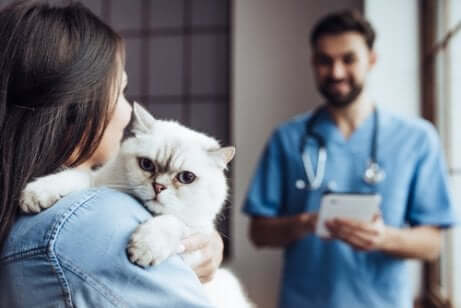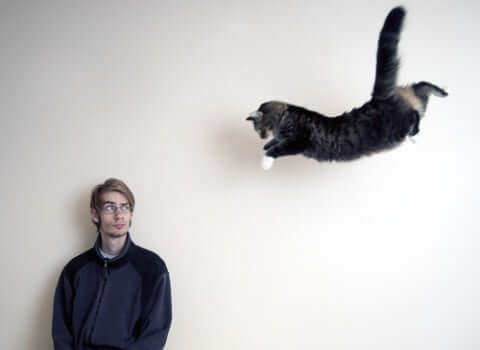Common Chiropractic Therapies for Cats

Chiropractic therapies for cats offer significant benefits to your cat’s health. However, these chiropractic therapies differ between felines.
Each cat is different. Although their bodies work in similar ways, there are small details that vary between cats. A good professional will understand your pet’s particularities and know which therapy is best for them.
A chiropractor is a professional who will understand how your cat’s nervous system works. They are also trained to alleviate any problems that your cat may have due to an irritation in their nervous system.
A chiropractor will want to evaluate your cat’s spinal and limb motor skills. While this may seem unusual, many cats suffer from orthopedic problems.
Initially, the chiropractor will use palpitations and initial assessments to determine the condition of your cat’s body. For cats, it’s especially very important that their vertebrae are in perfect condition.

Things to consider before choosing a chiropractor
A chiropractor should explain the therapeutic process carefully before starting any chiropractic therapies for cats. We recommend that you and the chiropractor reach an understanding and establish trust.
You should feel free to ask any questions before therapy with your feline. Chiropractic therapies for cats are delicate processes that require a properly trained professional.
If you’re not sure what features you should look for in a chiropractor, we recommend you start with the following:
- Ask your regular veterinarian about your cat’s medical history. A chiropractor will need to be properly informed about his patient before any treatment.
- Ask about any concepts you don’t understand. Sometimes medical professionals use technical language. If you don’t understand a term, don’t be afraid to ask!
- A professional working with your cat should be able to alleviate your worries and calm your cat. Watch your cat interact with the chiropractor before any therapy. That way, you can see if they get along well.
- We recommend that you find a specialist willing to take their time with you and your cat.
Typically, chiropractic therapies for cats go best when the professional works quietly. Cats are prone to get excited from sudden movements or loud noises. During chiropractic treatment, the animal should be in a calm environment.
Symptoms that indicate the need for chiropractic therapies for cats
Felines benefit from a variety of chiropractic therapies. Even if your cat doesn’t exercise a lot, all cats are athletic animals. It’s in their nature.
Because of this, all cats should be able to jump, run, turn, and stretch without any inconvenience. Accidental falls can cause cats to suffer problems with their spines.

When a cat’s spine is unbalanced, it affects their nervous system. As a result, an irritated nervous system can lead to problems in your cat’s organs and muscles.
The symptoms that indicate an imbalance in the spine can be varied. Your cat may experience unexpected or unusual tiredness. They may also be reluctant to interact with humans or other animals.
Some cats, when suffering from nervous problems, may have sudden mood swings. Many cats show aggression or depression, with decreased appetite.
All these symptoms show themselves progressively, so you must be very attentive to your cat’s behavior. It may take some time to notice these symptoms so you should always consult your veterinarian.
Chiropractic therapies for cats shouldn’t replace trips to the vet. Even if you seek alternative medicine for your cat, you still need to also have your pet evaluated by a traditional veterinarian.
Chiropractic techniques are complementary to traditional medicine. The effects are most beneficial when they are part of a recovery program designed in connection with your usual veterinarian.
Chiropractic therapies for cats offer significant benefits to your cat’s health. However, these chiropractic therapies differ between felines.
Each cat is different. Although their bodies work in similar ways, there are small details that vary between cats. A good professional will understand your pet’s particularities and know which therapy is best for them.
A chiropractor is a professional who will understand how your cat’s nervous system works. They are also trained to alleviate any problems that your cat may have due to an irritation in their nervous system.
A chiropractor will want to evaluate your cat’s spinal and limb motor skills. While this may seem unusual, many cats suffer from orthopedic problems.
Initially, the chiropractor will use palpitations and initial assessments to determine the condition of your cat’s body. For cats, it’s especially very important that their vertebrae are in perfect condition.

Things to consider before choosing a chiropractor
A chiropractor should explain the therapeutic process carefully before starting any chiropractic therapies for cats. We recommend that you and the chiropractor reach an understanding and establish trust.
You should feel free to ask any questions before therapy with your feline. Chiropractic therapies for cats are delicate processes that require a properly trained professional.
If you’re not sure what features you should look for in a chiropractor, we recommend you start with the following:
- Ask your regular veterinarian about your cat’s medical history. A chiropractor will need to be properly informed about his patient before any treatment.
- Ask about any concepts you don’t understand. Sometimes medical professionals use technical language. If you don’t understand a term, don’t be afraid to ask!
- A professional working with your cat should be able to alleviate your worries and calm your cat. Watch your cat interact with the chiropractor before any therapy. That way, you can see if they get along well.
- We recommend that you find a specialist willing to take their time with you and your cat.
Typically, chiropractic therapies for cats go best when the professional works quietly. Cats are prone to get excited from sudden movements or loud noises. During chiropractic treatment, the animal should be in a calm environment.
Symptoms that indicate the need for chiropractic therapies for cats
Felines benefit from a variety of chiropractic therapies. Even if your cat doesn’t exercise a lot, all cats are athletic animals. It’s in their nature.
Because of this, all cats should be able to jump, run, turn, and stretch without any inconvenience. Accidental falls can cause cats to suffer problems with their spines.

When a cat’s spine is unbalanced, it affects their nervous system. As a result, an irritated nervous system can lead to problems in your cat’s organs and muscles.
The symptoms that indicate an imbalance in the spine can be varied. Your cat may experience unexpected or unusual tiredness. They may also be reluctant to interact with humans or other animals.
Some cats, when suffering from nervous problems, may have sudden mood swings. Many cats show aggression or depression, with decreased appetite.
All these symptoms show themselves progressively, so you must be very attentive to your cat’s behavior. It may take some time to notice these symptoms so you should always consult your veterinarian.
Chiropractic therapies for cats shouldn’t replace trips to the vet. Even if you seek alternative medicine for your cat, you still need to also have your pet evaluated by a traditional veterinarian.
Chiropractic techniques are complementary to traditional medicine. The effects are most beneficial when they are part of a recovery program designed in connection with your usual veterinarian.
All cited sources were thoroughly reviewed by our team to ensure their quality, reliability, currency, and validity. The bibliography of this article was considered reliable and of academic or scientific accuracy.
- Riviére, S. (2007) Fisioterapia en gatos y perros aplicada a los trastornos locomotores de origen artrítico. Veterinary Focus, Volumen 17, No. 3.
- Poveda, F. (2008) Terapia de masajes y shiatsu como rehabilitación física en pequeños animales. Universidad de La Salle, Bogotá.
This text is provided for informational purposes only and does not replace consultation with a professional. If in doubt, consult your specialist.








